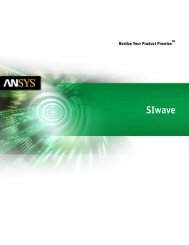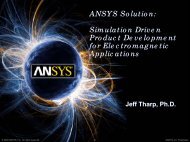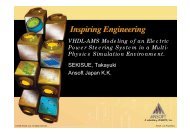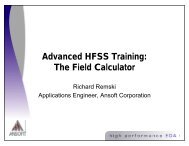Electrical Circuit Battery Modeling in Simplorer - Ansys
Electrical Circuit Battery Modeling in Simplorer - Ansys
Electrical Circuit Battery Modeling in Simplorer - Ansys
Create successful ePaper yourself
Turn your PDF publications into a flip-book with our unique Google optimized e-Paper software.
<strong>Electrical</strong> <strong>Circuit</strong> <strong>Battery</strong><br />
<strong>Model<strong>in</strong>g</strong> <strong>in</strong> <strong>Simplorer</strong> ®<br />
<strong>Electrical</strong> <strong>Circuit</strong> <strong>Battery</strong><br />
<strong>Model<strong>in</strong>g</strong> <strong>in</strong> <strong>Simplorer</strong> ®<br />
Xiao Hu<br />
Eric L<strong>in</strong><br />
Zed Tang<br />
Scott Stanton<br />
ANSYS Inc<br />
October, 2009<br />
© 2009 ANSYS, Inc. All rights reserved. 1 ANSYS, Inc. Proprietary
<strong>Circuit</strong> Model Motivation<br />
• Simple enough for system level analysis<br />
– Models based on detailed electrochemistry or detailed<br />
CFD analysis is too complex and/or too time<br />
consum<strong>in</strong>g for system level analysis<br />
• Accurate enough for virtual prototyp<strong>in</strong>g<br />
– Non-l<strong>in</strong>ear circuit voltage as a function of SOC<br />
– Transient I-V performance<br />
– Runtime prediction<br />
– Rate dependent capacity<br />
– Temperature effect<br />
– Accurate transient temperature prediction<br />
© 2009 ANSYS, Inc. All rights reserved. 2 ANSYS, Inc. Proprietary
Outl<strong>in</strong>e of Models<br />
• Chen’s electrical model<br />
– Accurate if temperature and discharge rate is constant<br />
• Gao’s modification<br />
– Introduces temperature and discharge rate effect<br />
– Thermal network model <strong>in</strong>troduced<br />
• Foster network thermal model<strong>in</strong>g<br />
– As accurate as CFD or test<strong>in</strong>g<br />
• <strong>Battery</strong> system example<br />
© 2009 ANSYS, Inc. All rights reserved. 3 ANSYS, Inc. Proprietary
Chen’s <strong>Electrical</strong> <strong>Battery</strong> Cell<br />
Model<br />
• Accounts for non-l<strong>in</strong>ear opencircuit<br />
voltage<br />
• Capable of predict<strong>in</strong>g runtime<br />
– Error less than 0.4%<br />
• Capable of predict<strong>in</strong>g<br />
transient I-V performance<br />
– Error less than 30-mV<br />
• Can be implemented easily <strong>in</strong><br />
Rself-Discharge = 0<br />
circuit simulator<br />
– Current implementation is<br />
done <strong>in</strong> <strong>Simplorer</strong> ® Reference: M. Chen, G. A. R<strong>in</strong>con-Mora, “Accurate electrical battery<br />
model capable of predict<strong>in</strong>g Runtime and I-V performance,”IEE<br />
Trans. On energy conversion, vol. 21, no. 2, June 2006<br />
© 2009 ANSYS, Inc. All rights reserved. 4 ANSYS, Inc. Proprietary
Results – Comparison<br />
• Pulse discharge and charge.<br />
Results from <strong>Simplorer</strong> ®<br />
Results from Chen<br />
Reference: M. Chen, G. A. R<strong>in</strong>con-Mora, “Accurate electrical battery model capable of predict<strong>in</strong>g Runtime and I-V performance,”IEE Trans. On<br />
energy conversion, vol. 21, no. 2, June 2006<br />
© 2009 ANSYS, Inc. All rights reserved. 5 ANSYS, Inc. Proprietary
Experimental Observation<br />
• Chen’s model works OK<br />
compared with test<strong>in</strong>g data.<br />
– Under constant temperature<br />
and discharge rate<br />
• Rate effect and temperature<br />
effect are important to<br />
consider<br />
Reference: L. Gao, S. Liu, and R. A. Dougal, “Dynamic lithium-ion battery model for<br />
system simulation,” IEEE Trans, Compon. Packag. Technol., vol. 25, no. 3, pp. 495-<br />
505, Sep. 2002<br />
Impact of discharge rate<br />
Impact of temperature<br />
© 2009 ANSYS, Inc. All rights reserved. 6 ANSYS, Inc. Proprietary
Suggested Modification by Gao<br />
• The discharge history is sensitized to rate of discharge and<br />
temperature through rate factor and temperature factor<br />
Chen’s model<br />
Gao’s model<br />
Rate factor Temperature factor<br />
Reference: L. Gao, S. Liu, and R. A. Dougal, “Dynamic lithium-ion battery model for system simulation,” IEEE Trans, Compon. Packag.<br />
Technol., vol. 25, no. 3, pp. 495-505, Sep. 2002<br />
© 2009 ANSYS, Inc. All rights reserved. 7 ANSYS, Inc. Proprietary
Complete <strong>Circuit</strong> Model for Li-ion <strong>Battery</strong>: 1 Cell<br />
• <strong>Electrical</strong> circuit and thermal<br />
circuit are coupled<br />
• <strong>Electrical</strong> circuit provides<br />
power to thermal circuit<br />
• Thermal circuit provides<br />
temperature to electrical<br />
circuit<br />
• Includes Positive<br />
Temperature Coefficient<br />
(PTC)<br />
© 2009 ANSYS, Inc. All rights reserved. 8 ANSYS, Inc. Proprietary<br />
Rconv<br />
<strong>Electrical</strong>/thermal <strong>in</strong>teraction<br />
Rcond Rcond<br />
T1 T2 Tptc<br />
Ambient<br />
Rconv Rconv
<strong>Simplorer</strong> ® Implementation of Gao’s<br />
Model with PTC and 3 T Nodes<br />
Implemented<br />
us<strong>in</strong>g VHDL-AMS<br />
© 2009 ANSYS, Inc. All rights reserved. 9 ANSYS, Inc. Proprietary
Results –Rate/Temperature Effect<br />
Added<br />
Impact of rate<br />
Impact of temperature<br />
© 2009 ANSYS, Inc. All rights reserved. 10 ANSYS, Inc. Proprietary
Results – No Overload<strong>in</strong>g<br />
• Discharge with a resistor of 10 Ohm.<br />
• Temperature close to ambient<br />
Voltage PTC and <strong>Battery</strong> Temperature<br />
© 2009 ANSYS, Inc. All rights reserved. 11 ANSYS, Inc. Proprietary
Results – Overload<strong>in</strong>g<br />
• Discharge with a resistor of 2 Ohm.<br />
• Temperature of PTC goes high<br />
Voltage PTC and <strong>Battery</strong> Temperature<br />
© 2009 ANSYS, Inc. All rights reserved. 12 ANSYS, Inc. Proprietary
From Thermal Network to Foster<br />
Network<br />
• Even though the thermal network method works OK, the model<br />
has limited accuracy due to the fact that it has only a limited<br />
number of thermal nodes, two <strong>in</strong> the example<br />
• A Foster network can be used to replace the thermal network<br />
• Foster network is as accurate as CFD or test<strong>in</strong>g<br />
• A Foster network is a ladder of RC<br />
network shown<br />
• The response of the Foster network<br />
system is a sum of several<br />
exponentially decay<strong>in</strong>g terms.<br />
© 2009 ANSYS, Inc. All rights reserved. 13 ANSYS, Inc. Proprietary<br />
0<br />
R1<br />
C1 C2<br />
R2 R3<br />
R4<br />
Foster network<br />
R5<br />
R6<br />
C3 C4 C5 C6
What is an LTI system?<br />
• A LTI system is a L<strong>in</strong>ear Time Invariant (LTI) system<br />
• L<strong>in</strong>ear means that it satisfies superposition<br />
• Time <strong>in</strong>variant means the behavior will not change if you test it tomorrow<br />
• The Foster network is a LTI system<br />
• <strong>Battery</strong> cool<strong>in</strong>g problem can be treated like a system, <strong>in</strong> which the<br />
<strong>in</strong>puts are the power generated by <strong>in</strong>dividual batteries and the<br />
outputs are temperatures at user specified locations<br />
• Under certa<strong>in</strong> conditions, such a system is a LTI system<br />
<strong>Battery</strong>1 Power<br />
<strong>Battery</strong>2 Power<br />
<strong>Battery</strong>3 Power<br />
© 2009 ANSYS, Inc. All rights reserved. 14 ANSYS, Inc. Proprietary<br />
LTI<br />
Temperature1<br />
Temperature2<br />
Temperature3
Characteristics of LTI Systems<br />
• Impulse (or step) response completely characterize such<br />
systems<br />
• The Laplace transform of the impulse response is the transfer<br />
function of such a system<br />
• Any transient response of the system is the convolution of <strong>in</strong>put<br />
and the impulse response<br />
• If two LTI systems have the same impulse (or step) response (or<br />
transfer function), then the two systems have identical<br />
behavior.<br />
• The output of the two systems are the same provided that the<br />
<strong>in</strong>put to the two systems are the same – one can replace one<br />
with another even though two systems may have completely<br />
different <strong>in</strong>ternal structure<br />
• <strong>Electrical</strong> analogy works for mechanical/thermal systems<br />
• Both the Foster network and battery system are LTI<br />
systems<br />
• If we can f<strong>in</strong>d resistance and capacitance of the Foster network<br />
such that it has the same impulse (or step) response as the<br />
battery thermal system, the transient behavior of the battery<br />
system can be represented by the Foster network.<br />
© 2009 ANSYS, Inc. All rights reserved. 15 ANSYS, Inc. Proprietary
<strong>Electrical</strong> Model Plus LTI Foster<br />
Network<br />
• <strong>Electrical</strong> circuit part is unchanged<br />
• Thermal network model is replaced with the Foster<br />
network<br />
– The Foster network is curve fitted to have the same<br />
impulse (or step) response as the battery thermal<br />
system us<strong>in</strong>g CFD.<br />
• <strong>Battery</strong> circuit model provides power to Foster<br />
network and Foster network returns temperature to<br />
battery circuit model<br />
– This aspect is similar to the thermal network approach<br />
© 2009 ANSYS, Inc. All rights reserved. 16 ANSYS, Inc. Proprietary
Complete <strong>Circuit</strong> Model for Li-ion <strong>Battery</strong>: 1<br />
Pack<br />
• <strong>Electrical</strong> circuit and Foster<br />
network are coupled<br />
• <strong>Electrical</strong> circuit provides<br />
power to Foster network<br />
• Foster network provides<br />
temperature to electrical<br />
circuit<br />
<strong>Battery</strong>1 Power<br />
<strong>Battery</strong>2 Power<br />
<strong>Battery</strong>3 Power<br />
<strong>Electrical</strong>/thermal <strong>in</strong>teraction<br />
Foster LTI<br />
Temperature1<br />
Temperature2<br />
Temperature2<br />
© 2009 ANSYS, Inc. All rights reserved. 17 ANSYS, Inc. Proprietary
Example<br />
• The thermal model is replaced by a LTI Foster network<br />
• The Foster network is curve fitted to have the same<br />
impulse response as CFD.<br />
• Us<strong>in</strong>g step response for curve fitt<strong>in</strong>g is also OK.<br />
• The LTI Foster network is then as accurate as CFD<br />
<strong>Battery</strong>3<br />
<strong>Battery</strong>4<br />
<strong>Battery</strong>0<br />
<strong>Battery</strong>5<br />
<strong>Battery</strong>1<br />
<strong>Battery</strong>2<br />
Fluid Flow<br />
Region<br />
© 2009 ANSYS, Inc. All rights reserved. 18 ANSYS, Inc. Proprietary
LTI Foster Network Model – <strong>Simplorer</strong> ®<br />
Implementation of One Pack<br />
• The LTI Foster network model is with<strong>in</strong> a sub-circuit<br />
Ccapacity<br />
C1<br />
C4<br />
C7<br />
C10<br />
C13<br />
0<br />
0<br />
0<br />
0<br />
0<br />
0<br />
IBatt<br />
I7<br />
I8<br />
I9<br />
I10<br />
I11<br />
0<br />
VOC<br />
E1<br />
E2<br />
E3<br />
E4<br />
E5<br />
Rseries<br />
R1<br />
R5<br />
R9<br />
R13<br />
R17<br />
CT_S<br />
RT_S<br />
R2<br />
CT_L<br />
C2 C3<br />
R6<br />
C5 C6<br />
RT_L<br />
R3<br />
R7<br />
R10 R11<br />
C8 C9<br />
R14<br />
C11 C12<br />
R15<br />
R18 R19<br />
C14 C15<br />
RLoad<br />
CONST1<br />
CONST<br />
CONST2<br />
CONST<br />
CONST3<br />
CONST<br />
CONST4<br />
CONST<br />
CONST5<br />
CONST<br />
CONST6<br />
CONST<br />
Y1<br />
37.50<br />
25.00<br />
12.50<br />
I1<br />
I2<br />
I3<br />
I4<br />
I5<br />
I6<br />
Port1<br />
Port2<br />
Port3<br />
Port4<br />
Port5<br />
Port6<br />
Port7<br />
Port8<br />
Port9<br />
Port10<br />
Port11<br />
Port12<br />
LTI <strong>Circuit</strong><br />
U1<br />
<strong>Simplorer</strong>2<br />
© 2009 ANSYS, Inc. All rights reserved. 19 ANSYS, Inc. Proprietary<br />
T00<br />
T01<br />
T02<br />
T03<br />
T04<br />
T05<br />
Curve Info<br />
U1.T00<br />
TR<br />
U1.T01<br />
TR<br />
U1.T02<br />
TR<br />
U1.T03<br />
TR<br />
U1.T04<br />
TR<br />
U1.T05<br />
TR<br />
0.00<br />
0.00 200.00 400.00 600.00<br />
Time [s ]<br />
800.00 1000.00 1200.00<br />
batt00_P_<strong>in</strong>put<br />
batt01_P_<strong>in</strong>put<br />
batt02_P_<strong>in</strong>put<br />
0<br />
0<br />
0<br />
0<br />
0<br />
0<br />
+<br />
V<br />
VM1<br />
+<br />
V<br />
VM2<br />
+<br />
V<br />
VM4<br />
+<br />
V<br />
VM3<br />
+<br />
V<br />
VM5<br />
+<br />
V<br />
VM6<br />
R1 R2 R4 R5<br />
R8 R7 R6 R3<br />
R9 R10 R11 R12<br />
R16 R15 R14 R13<br />
R17 R18 R19 R20<br />
R24 R23 R22 R21<br />
C1 C2 C4 C5<br />
C8 C7 C6 C3<br />
C9 C10 C11 C12<br />
C16 C15 C14 C13<br />
C17 C18 C19 C20<br />
C24 C23 C22 C21<br />
+<br />
V<br />
VM24<br />
+<br />
V<br />
VM23<br />
+<br />
V<br />
VM21<br />
+<br />
V<br />
VM22<br />
+<br />
V<br />
VM20<br />
+<br />
V<br />
VM19<br />
+<br />
V<br />
+<br />
V<br />
R48 R47 R46 R45<br />
R41 R42 R43 R44<br />
R40 R39 R38 R37<br />
R33 R34 R35 R36<br />
R32 R31 R30 R29<br />
R25 R26 R27 R28<br />
C48 C47 C46 C45<br />
C41 C42 C43 C44<br />
C40 C39 C38 C37<br />
C33 C34 C35 C36<br />
C32 C31 C30 C29<br />
C25 C26 C27 C28<br />
+<br />
V<br />
VM25<br />
+<br />
V<br />
VM26<br />
+<br />
V<br />
VM28<br />
+<br />
V<br />
VM27<br />
+<br />
V<br />
VM29<br />
+<br />
V<br />
VM30<br />
R49 R50 R51 R52<br />
R56 R55 R54 R53<br />
R57 R58 R59 R60<br />
R64 R63 R62 R61<br />
R65 R66 R67 R68<br />
R72 R71 R70 R69<br />
C49 C50 C51 C52<br />
C56 C55 C54 C53<br />
C57 C58 C59 C60<br />
C64 C63 C62 C61<br />
C65 C66 C67 C68<br />
C72 C71 C70 C69<br />
batt03_P_<strong>in</strong>put<br />
batt04_P_<strong>in</strong>put<br />
batt05_P_<strong>in</strong>put<br />
+<br />
V<br />
VM48<br />
+<br />
V<br />
VM47<br />
+<br />
V<br />
VM45<br />
+<br />
V<br />
VM46<br />
+<br />
V<br />
VM44<br />
+<br />
V<br />
VM43<br />
+<br />
V<br />
+<br />
V<br />
R96 R95 R94 R93<br />
R89 R90 R91 R92<br />
R88 R87 R86 R85<br />
R81 R82 R83 R84<br />
R80 R79 R78 R77<br />
R73 R74 R75 R76<br />
C96 C95 C94 C93<br />
C89 C90 C91 C92<br />
C88 C87 C86 C85<br />
C81 C82 C83 C84<br />
C80 C79 C78 C77<br />
C73 C74 C75 C76<br />
+<br />
V<br />
VM49<br />
+<br />
V<br />
VM50<br />
C97 C98 C99 C100<br />
+<br />
V<br />
VM52<br />
C104 C103<br />
+<br />
V<br />
VM51<br />
+<br />
V<br />
VM53<br />
+<br />
V<br />
VM54<br />
R97 R98 R99 R100<br />
R104 R103 R102 R101<br />
R105 R106 R107 R108<br />
R112 R111 R110 R109<br />
R113 R114 R115 R116<br />
R120 R119 R118 R117<br />
+<br />
V<br />
VM72<br />
+<br />
V<br />
VM71<br />
+<br />
V<br />
VM69<br />
C102 C101<br />
C105 C106 C107 C108<br />
+<br />
V<br />
VM70<br />
+<br />
V<br />
VM68<br />
+<br />
V<br />
VM67<br />
+<br />
V<br />
VM8<br />
VM17<br />
VM32<br />
VM41<br />
VM56<br />
C112 C111<br />
C136 C135 C134 C133<br />
C129 C130 C131 C132<br />
+<br />
V<br />
VM65<br />
+<br />
V<br />
+<br />
V<br />
+<br />
V<br />
+<br />
V<br />
+<br />
V<br />
VM7<br />
VM18<br />
VM31<br />
VM42<br />
VM55<br />
+<br />
V<br />
+<br />
V<br />
+<br />
V<br />
+<br />
V<br />
+<br />
V<br />
VM9<br />
VM16<br />
VM33<br />
VM40<br />
VM57<br />
+<br />
V<br />
+<br />
V<br />
+<br />
V<br />
+<br />
V<br />
+<br />
V<br />
VM10<br />
VM15<br />
VM34<br />
VM39<br />
VM58<br />
C110 C109<br />
C113 C114 C115 C116<br />
+<br />
V<br />
VM66<br />
+<br />
V<br />
VM64<br />
C128 C127<br />
+<br />
V<br />
VM63<br />
+<br />
V<br />
+<br />
V<br />
+<br />
V<br />
+<br />
V<br />
+<br />
V<br />
VM12<br />
VM13<br />
VM36<br />
VM37<br />
VM60<br />
C120 C119<br />
+<br />
V<br />
VM61<br />
+<br />
V<br />
+<br />
V<br />
+<br />
V<br />
+<br />
V<br />
+<br />
V<br />
VM11<br />
VM14<br />
VM35<br />
VM38<br />
VM59<br />
C118 C117<br />
R144 R143 R142 R141<br />
R137 R138 R139 R140<br />
R136 R135 R134 R133<br />
R129 R130 R131 R132<br />
R128 R127 R126 R125<br />
R121 R122 R123 R124<br />
C144 C143<br />
C142 C141<br />
C137 C138 C139 C140<br />
+<br />
V<br />
VM62<br />
C126 C125<br />
C121 C122 C123 C124
LTI Foster Network Model Results<br />
• Results from the Foster network are so close to Fluent that they are on top of each<br />
other<br />
<strong>Battery</strong> 0 <strong>Battery</strong> 1 <strong>Battery</strong> 2<br />
<strong>Battery</strong> 3 <strong>Battery</strong> 4 <strong>Battery</strong> 5<br />
© 2009 ANSYS, Inc. All rights reserved. 20 ANSYS, Inc. Proprietary
System Level <strong>Circuit</strong> Model for Li-ion <strong>Battery</strong><br />
• Cells connected <strong>in</strong> series and parallel<br />
comb<strong>in</strong>ations to form packs<br />
• Packs are then connected series and<br />
parallel comb<strong>in</strong>ations to form f<strong>in</strong>al<br />
configuration<br />
© 2009 ANSYS, Inc. All rights reserved. 21 ANSYS, Inc. Proprietary
An Example of Sixty Cells <strong>in</strong> Serial and Parallel<br />
Five cells<br />
© 2009 ANSYS, Inc. All rights reserved. 22 ANSYS, Inc. Proprietary
Results – Voltage and Current<br />
• The peak voltage is approximately 16 V<br />
– Result of serial connection of four batteries<br />
• The peak current drawn is approximately 3.25 Amp compared with 0.4<br />
Amp for s<strong>in</strong>gle battery case. And yet the runtime is almost doubled.<br />
– Result of parallel connection of 15 batteries<br />
– Estimated to be 0.4/(3.25/15)x8000 sec without rate factor consideration<br />
Voltage Current<br />
© 2009 ANSYS, Inc. All rights reserved. 23 ANSYS, Inc. Proprietary
<strong>Battery</strong> <strong>in</strong> a Control System with a Motor<br />
Controller<br />
<strong>Battery</strong><br />
© 2009 ANSYS, Inc. All rights reserved. 24 ANSYS, Inc. Proprietary
2600.00<br />
2400.00<br />
2200.00<br />
2000.00<br />
1800.00<br />
1600.00<br />
Results – Motor Performance<br />
Ansoft LLC <strong>in</strong>duction_mach<strong>in</strong>e_DC_BusCap<br />
2800.00<br />
Curve Info<br />
Vel_com<br />
Velocity Command<br />
0.00 200.00 400.00 600.00 800.00 1000.00<br />
Time [s]<br />
Velocity Command<br />
TR<br />
Vel_com<br />
Ansoft LLC <strong>in</strong>duction_mach<strong>in</strong>e_DC_BusCap<br />
250.00<br />
Curve Info<br />
ASM_2.MI [NewtonMeter]<br />
200.00<br />
150.00<br />
100.00<br />
50.00<br />
0.00<br />
Torque<br />
Ansoft LLC <strong>in</strong>duction_mach<strong>in</strong>e_DC_BusCap<br />
2800.00<br />
Curve Info<br />
0.00 200.00 400.00 600.00 800.00 1000.00<br />
Time [s]<br />
Measured Rotor Speed<br />
Torque<br />
© 2009 ANSYS, Inc. All rights reserved. 25 ANSYS, Inc. Proprietary<br />
ASM_2.N [rpm]<br />
2600.00<br />
2400.00<br />
2200.00<br />
2000.00<br />
1800.00<br />
1600.00<br />
ASM_2.MI<br />
TR<br />
0.00 200.00 400.00 600.00 800.00 1000.00<br />
Time [s]<br />
Measured Rotor Speed<br />
TR<br />
ASM_2.N
Results – <strong>Battery</strong> Performance<br />
Ansoft LLC <strong>in</strong>duction_mach<strong>in</strong>e_DC_BusCap<br />
200.00<br />
Curve Info<br />
VM2.V [V]<br />
175.00<br />
150.00<br />
125.00<br />
100.00<br />
75.00<br />
50.00<br />
25.00<br />
0.00<br />
<strong>Battery</strong> Voltage<br />
Rotor speed<br />
0.00 200.00 400.00 600.00 800.00 1000.00<br />
Time [s]<br />
<strong>Battery</strong> Voltage<br />
TR<br />
VM2.V<br />
Ansoft LLC <strong>in</strong>duction_mach<strong>in</strong>e_DC_BusCap<br />
300.00<br />
Curve Info<br />
0.00 200.00 400.00 600.00 800.00 1000.00<br />
Time [s]<br />
<strong>Battery</strong> Current<br />
© 2009 ANSYS, Inc. All rights reserved. 26 ANSYS, Inc. Proprietary<br />
AM4.I [A]<br />
250.00<br />
200.00<br />
150.00<br />
100.00<br />
50.00<br />
0.00<br />
<strong>Battery</strong> Current<br />
AM4.I<br />
TR
Conclusions<br />
• <strong>Electrical</strong> battery models implemented <strong>in</strong> <strong>Simplorer</strong> ® have<br />
demonstrated its capability to capture battery non-l<strong>in</strong>ear<br />
voltage, transient I-V performance, etc.<br />
• Models have been tested <strong>in</strong> system environment us<strong>in</strong>g a control<br />
system with a motor controller<br />
• <strong>Circuit</strong> model can be coupled with thermal network model to<br />
<strong>in</strong>clude temperature effects on battery performance<br />
• Foster network has demonstrated its capability to replace CFD<br />
for thermal analysis s<strong>in</strong>ce it is as accurate as CFD<br />
• Advantages of <strong>Simplorer</strong><br />
– <strong>Circuit</strong> simulator for the electrical and thermal circuits.<br />
– Customizable us<strong>in</strong>g VHDL-AMS<br />
– Multi-doma<strong>in</strong> system level simulation quite easy and efficient<br />
– Communicates with ANSYS CFD/Mechanical and Maxwell.<br />
– <strong>Simplorer</strong> 8.1 automatically extracts the Foster network parameters<br />
© 2009 ANSYS, Inc. All rights reserved. 27 ANSYS, Inc. Proprietary
Appendix : list of papers<br />
• M. Chen, G. A. R<strong>in</strong>con-Mora, “Accurate electrical battery model<br />
capable of predict<strong>in</strong>g Runtime and I-V performance,” IEEE<br />
Trans. On energy conversion, vol. 21, no. 2, June 2006<br />
• L. Gao, S. Liu, and R. A. Dougal, “Dynamic lithium-ion battery<br />
model for system simulation,” IEEE Trans, Compon. Packag.<br />
Technol., vol. 25, no. 3, pp. 495-505, Sep. 2002<br />
© 2009 ANSYS, Inc. All rights reserved. 28 ANSYS, Inc. Proprietary
















